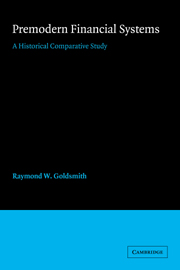Book contents
- Frontmatter
- Contents
- List of tables
- Preface
- 1 Introduction
- 2 The financial systems of the ancient Near East
- 3 The financial system of Periclean Athens
- 4 The financial system of Augustan Rome
- 5 The financial system of the early Abbasid caliphate
- 6 The financial system of the Ottoman Empire at the death of Suleiman I
- 7 The financial system of Mughal India at the death of Akbar
- 8 The financial system of early Tokugawa Japan
- 9 The financial system of Medici Florence
- 10 The financial system of Elizabethan England
- 11 The financial system of the United Provinces at the Peace of Münster
- 12 Similarities and differences
- Notes
- Bibliography
- Index
12 - Similarities and differences
Published online by Cambridge University Press: 05 March 2012
- Frontmatter
- Contents
- List of tables
- Preface
- 1 Introduction
- 2 The financial systems of the ancient Near East
- 3 The financial system of Periclean Athens
- 4 The financial system of Augustan Rome
- 5 The financial system of the early Abbasid caliphate
- 6 The financial system of the Ottoman Empire at the death of Suleiman I
- 7 The financial system of Mughal India at the death of Akbar
- 8 The financial system of early Tokugawa Japan
- 9 The financial system of Medici Florence
- 10 The financial system of Elizabethan England
- 11 The financial system of the United Provinces at the Peace of Münster
- 12 Similarities and differences
- Notes
- Bibliography
- Index
Summary
The purpose of this chapter is to permit a comparison of the main characteristics of the 10 cases presented by giving at least an idea of their similarities and differences without being able to do justice to their individualities or to explain the reasons for them. This goal is attempted by providing a very condensed description of the main characteristics of the economic infrastructure of each country covered – the population, urbanization, and size and distribution of income and wealth – and of its financial structure – monetary system, financial instruments and organizations, interest rates, and methods of financing the main sectors, particularly the government. These descriptions are necessarily so condensed that an appreciation of the significance of these features and of the limitations of the underlying evidence requires consultation of the relevant chapters. Thus most statements should be read as being prefaced by such expressions as “apparently,” “probably,” or “approximately.” An attempt to go beyond these descriptions has been made on only a few points. The time for an explanation of the reasons of the observed differences or for a synthesis of the financial history of the world before the eighteenth century does not yet seem to have come, if only because of the limitations of the available data, particularly if they are to be expressed in quantitative terms, the approach attempted throughout the study.
- Type
- Chapter
- Information
- Premodern Financial SystemsA Historical Comparative Study, pp. 229 - 252Publisher: Cambridge University PressPrint publication year: 1987

